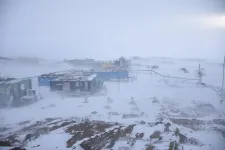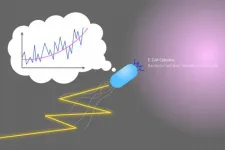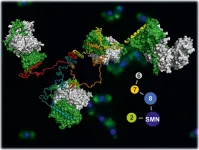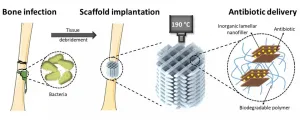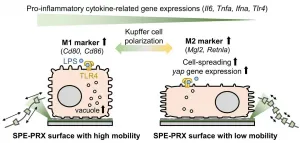(Press-News.org) At the bottom of the world, there's a small island about four kilometers off the coast of Antarctica. In summer, temperatures climb to freezing with uninterrupted daylight for two months. In winter, they fall to minus 40 degrees Celsius without a single sunrise for two months. It is isolated and desolate, uninhabitable to all humans -- except for the Japanese Antarctic Research Expedition (JARE). Almost every year since 1956, a JARE team winters over on the island, staying in Syowa Station, from February to January to conduct various research projects. From 2004 to 2014, however, they were also research subjects themselves.
As part of a joint project between the National Institute of Polar Research at the Research Organization of Information and Systems (ROIS) and the Antarctic Psychological Research team at Kyoto University, a series of non-invasive psychological surveys were administered six times to five different wintering-over teams.
The results were published online on Feb. 22 in the International Journal of Circumpolar Health.
"An Antarctic wintering-over station is a unique environment as a small, isolated society facing the extreme margins of survival," said first author Tomoko Kuwabara, professor emeritus in the Graduate School of Education at Kyoto University and professor in The Open University of Japan. "Although significant developments have been made in wintering-over operations, such as improved communications, it is still hard to stay an entire year in an Antarctic station, not only because of the cold, changes in daylight and exposure to UV rays, but also the isolation and the impossibility of escaping one's small social group. These conditions make an Antarctic station a unique society that can reveal much about human nature."
To better understand how team members' psychological states changed throughout their wintering-over experience, the 172 participants were asked to complete a questionnaire designed to assess mood and to draw trees. Known as the Baum test, how a participant draws trees is thought to reveal much about their mental state and personality.
Some participants depicted trees reminiscent of Japan, such as cherry trees or even a tree in a home garden, while others drew palm trees. Many sketched apple trees.
The researchers noticed the team members split themselves in two distinct groups: Those who drew the same trees every time they were asked, and those who drew different trees.
"These results suggest two types of coping among individuals: one stabilizes life by maintaining a previous lifestyle, and the other flexibly adjusts to a new way of life," Kuwabara said.
This assessment appeared to hold true across the questionnaires, but the researchers were unable to pinpoint any distinct personality traits that might make a person more or less suited to life at Antarctica.
"In general, wintering-over team members accepted their environment, and they did not act out emotionally or deny problems," Kuwabara said, noting that many seemed to draw comfort and stability from continuing to hold onto internal relationships with their family and home. "It is expected that our survey will contribute to the understanding of other isolated groups, such as crews on the space station or in other future space travel, as well as to group management in everyday societies."
The researchers plan to continue exploring how team members manage during wintering over, as well as how they readjust to typical life.
INFORMATION:
Co-authors include Nobuo Naruiwa, Department of Psychology, Faculty of Health Science, Kyoto Koka Women's University; Tetsuya Kawabe, Graduate School of Humanities and Sustainable System Sciences, Osaka Prefecture University; Nanako Kato, Department of Health Sciences, Faculty of Human Life and Environment, Nara Women's University; Asako Sasaki, Department of Student Affairs, Student Support Room, Ritsumeikan University; Atsushi Ikeda, Department of Urology, University of Tsukuba Hospital; Shinji Otani, International Platform for Dryland Research and Education, Tottori University; Satoshi Imura and Kentaro Watanabe, National Institute of Polar Research; and Giichiro Ohno, Department of Surgery, Tokatsu Hospital.
The National Institute of Polar Research, the Global Centers of Excellence Program and the Japan Society for the Promotion of Science funded this work.
About National Institute of Polar Research (NIPR)
The NIPR engages in comprehensive research via observation stations in Arctic and Antarctica. As a member of the Research Organization of Information and Systems (ROIS), the NIPR provides researchers throughout Japan with infrastructure support for Arctic and Antarctic observations, plans and implements Japan's Antarctic observation projects, and conducts Arctic researches of various scientific fields such as the atmosphere, ice sheets, the ecosystem, the upper atmosphere, the aurora and the Earth's magnetic field. In addition to the research projects, the NIPR also organizes the Japanese Antarctic Research Expedition and manages samples and data obtained during such expeditions and projects. As a core institution in researches of the polar regions, the NIPR also offers graduate students with a global perspective on originality through its doctoral program. For more information about the NIPR, please visit: https://http://www.nipr.ac.jp/english/
About the Research Organization of Information and Systems (ROIS)
The Research Organization of Information and Systems (ROIS) is a parent organization of four national institutes (National Institute of Polar Research, National Institute of Informatics, the Institute of Statistical Mathematics and National Institute of Genetics) and the Joint Support-Center for Data Science Research. It is ROIS's mission to promote integrated, cutting-edge research that goes beyond the barriers of these institutions, in addition to facilitating their research activities, as members of inter-university research institutes.
Materials science likes to take nature and the special properties of living beings that could potentially be transferred to materials as a model. A research team led by chemist Professor Andreas Walther of Johannes Gutenberg University Mainz (JGU) has succeeded in endowing materials with a bioinspired property: Wafer-thin stiff nanopaper instantly becomes soft and elastic at the push of a button. "We have equipped the material with a mechanism so that the strength and stiffness can be modulated via an electrical switch," explained Walther. As soon as an electric current is applied, the nanopaper becomes soft; when the current flow stops, it regains its strength. From an application perspective, this switchability could be interesting for damping ...
Tokyo, Japan - Scientists from the Graduate School of Information Science and Technology at The University of Tokyo calculated the efficiency of the sensory network that bacteria use to move towards food and found it to be optimal from an information theory standpoint. This work may lead to a better understanding of bacterial behavior and their sensory networks.
Despite being single-celled organisms, bacteria such as E. Coli can perform some impressive feats of sensing and adaptation in constantly changing environmental conditions. For example, these bacteria can sense the presence of a chemical ...
Imbued with special electric, mechanical and other physical properties due to their tiny size, nanofibers are considered leading-edge technology in biomedical engineering, clean energy and water quality control, among others. Now, researchers in Italy and UK have developed an automatic process to assess nanofiber fabrication quality, producing 30% more accurate results than currently used techniques.
Details were published on January 2021 in IEEE/CAA Journal of Automatica Sinica, a joint publication of the IEEE and the Chinese Association of Automation.
"In recent years, nanostructured materials have gained continuously growing interest both in scientific and industrial contexts, because of their research appeal and versatile applications," ...
SMN or in full Survival Motor Neuron: Professor Utz Fischer has been analyzing this protein and the large molecular complex of the same name, of which SMN is one of the building blocks, for many years. He holds the Chair of the Department of Biochemistry at the Julius-Maximilian's University of Würzburg (JMU), and he first discovered the molecule during his search for the root cause of spinal muscular atrophy. As scientists found out a few years ago, this disease is caused by a lack of the SNM complex.
The work group around Prof. Fischer has now succeeded in presenting a first three-dimensional model of the ...
In a ground-breaking first, researchers have fabricated 3D scaffold implants containing antibiotics at high temperatures. These scaffolds not only support bone regeneration but manage the bone infections that can arise as a result of injury or surgery.
Each year, around 4 million people worldwide develop bone infection following an open fracture or surgery. The gold standard treatment consists of a lengthy antibiotic therapy, usually delivered orally or Intravenously, and the removal of infected bone tissue, which often leaves behind a hole too large for the body to fill via normal bone regeneration. In a study published in the KeAi journal Bioactive Materials, a group of researchers from the Netherlands, Italy and Spain, outline a new treatment ...
A genetic variation that regulates iron metabolism may enhance athletes' endurance performance, researchers at the University of Toronto have shown.
The findings could help explain studies that show an association between the genetic variation and elite athletes across many sports, and may help competitive athletes fine-tune their iron intake to boost performance.
The variation, found in the homeostatic iron regulator (HFE) gene, is a known cause of iron overload, a condition called hemochromatosis in which the body absorbs too much iron leading to organ and joint damage.
Athletes at risk for hemochromatosis but with iron stores below potentially toxic levels could have ...
Bacteria plucked from a desert plant could help crops survive heatwaves and protect the future of food.
Global warming has increased the number of severe heatwaves that wreak havoc on agriculture, reduce crop yields and threaten food supplies. However, not all plants perish in extreme heat. Some have natural heat tolerance, while others acquire heat tolerance after previous exposure to higher temperatures than normal, similar to how vaccines trigger the immune system with a tiny dose of virus.
But breeding heat tolerant crops is laborious and expensive, and slightly warming entire fields is even trickier.
There is growing interest in harnessing microbes to protect plants, and biologists have shown that root-dwelling bacteria can help their herbaceous ...
Researchers from Tokyo Medical and Dental University (TMDU) identify biomaterials that can be used to modulate liver immune cell behavior
Tokyo, Japan - Biomaterials are substances, natural or manmade, that are used in medicine to interact with the human body for various purposes, such as wound healing and tissue regeneration. Previous work on biomaterials has shown that they can affect cells in many ways, including how they grow, move, and the type of cell they develop into. Scientists have recently begun investigating biomaterials with properties that can be fine-tuned to optimize their use in regenerative ...
Usually scaled, the skin of fish can also be naked or made up of bony plates that form an armour, sometimes even covered with teeth. But how has this skin evolved over the ages? To answer this question, researchers at the University of Geneva (UNIGE), Switzerland, have reconstructed the evolution of the protective skin structures in fish, going back to the common ancestor of ray-finned fish, more than 420 million years ago. They found that only fish that had lost their scales were able to develop a bony armour, and that the protective state of their skin influenced their choice of open water or sea floor habitats. This study, published in the journal Evolution Letters, provides a new explanation for the incredible ...
In spring 2020, when the first wave of the coronavirus pandemic hit Finland, older adults drastically reduced their out-of-home activities. During the period of government restrictions, physical exercise was the most common reason to leave home, a recent study at the University of Jyväskylä Faculty of Sport and Health Sciences finds.
"In spring 2020, it was feared that the closure of many activity destinations and the recommendations to avoid close contact with persons from other households put in place by the government would decrease physical activity levels, and thus, negatively affect older adults' physical functional capacity," Senior ...
